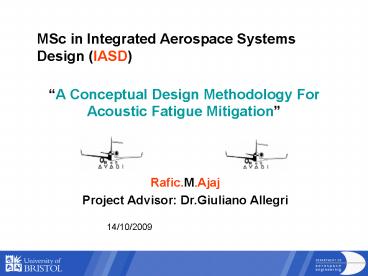A Conceptual Design Methodology For Acoustic Fatigue Mitigation - PowerPoint PPT Presentation
1 / 11
Title:
A Conceptual Design Methodology For Acoustic Fatigue Mitigation
Description:
To simplify the process, Aquila is used as a reference aircraft' ... The trade-off between fatigue performance, cost, and weight depends mainly on ... – PowerPoint PPT presentation
Number of Views:37
Avg rating:3.0/5.0
Title: A Conceptual Design Methodology For Acoustic Fatigue Mitigation
1
A Conceptual Design Methodology For Acoustic
Fatigue Mitigation
MSc in Integrated Aerospace Systems Design (IASD)
- Rafic.M.Ajaj
- Project Advisor Dr.Giuliano Allegri
14/10/2009
2
Contents
- Objectives
- Problem Definition
- Methodology Outline
- Noise Estimation Process
- Parametric Study
- Costing Analysis
- Conclusions
3
Objectives
- To establish a conceptual design methodology in a
multi-disciplinary framework for acoustic fatigue
mitigation in aircraft structures positioned
close to engine efflux - To generalize the applicability of this
methodology to cover most aircraft morphologies
and advanced aerospace material systems - To illustrate, in the format of a case study
covering three aerospace materials, the material
system with the superior fatigue performance - To elaborate the significance of acoustic fatigue
problems on innovative aircraft morphologies
powered by 2020 turbofans - To reduce the number of design iterations during
the conceptual design phase, and yield more
accurate outcomes
4
- Problem Definition
- The need to establish a methodology to mitigate
acoustic fatigue is driven by the followings - Passive airframe/engine shielding using
innovative morphologies(BWB) leads to increase in
localized exposure of airframe components to
acoustic loading - The market demand for more electric aircrafts
urges to adopt more powerful engines thus
increasing noise emissions - Crack initiation and propagation due to acoustic
fatigue have significant impacts on the
inspection frequencies - Development of new aerospace materials (FRP,FML)
that have widely different dynamic
characteristics under acoustic loadings - High costs associated with structural failures
5
- Methodology Outline
- quantifying noise emission from an ACARE 2020
compliant turbofan engine and identify the
skin/stringer panel subject to the highest
acoustic loading - 2. conducting a parametric study over
safe-life critical skin/stringer panels designs
with different geometries and made-up from
different materials, and estimate their
cumulative endurance - estimating the costs associated with safe-life
design of structural panels subjected to sonic
loading - To simplify the process, Aquila is used as a
reference aircraft - (i.e. a design that doesnt lead to cascade
failure over the design life of the vehicle)
6
- Noise estimation Process
- Noise mapping is performed over the lower wing
panel of Aquila to define the critical panel
which is subject to the highest acoustic level.
The noise level varies significantly over the
critical panel at various flight segments
7
- Parametric Study
- The study consists of five major steps
- Estimate the natural frequency of the critical
panel - (Using Lin semi-analytical method)
- Estimate the RMS stress/strain at each flight
segment - (Using ESDU 73014 method)
- Obtain the endurance using safe-life design
curves at each flight segment - (Using S-N curves from ESDU applying a
scatter factor) - Estimate the total number of missions flown prior
to cracks initiation using Miners Rule and
present them in the form of nomographs - Couple the nomographs with the SEER-H costing
tool (bottom-up) for the Aquila case to show the
impact of safe-life design on the cost of the
panels
To generalize the applicability of such study,
the geometry of different critical skin/stringer
panels( thickness, stringer pitch) has been
varied for different materials
Al2024-T3,Glare-3,and CFEP
8
Superior fatigue performance of CFEP
It points out that CFEP panels have the best
acoustic fatigue performance followed by
Glare-3,and finally Al 2024-T3 panels
To illustrate that CFEP panels have superior
fatigue performance over panels made from other
material systems, three critical skin/stringer
panels of T-tail conventional aircraft are
considered they have the same geometry but are
made from different materials
CFEP proves to be the best candidate materials
for skin/stringer panels positioned close to the
jet efflux, as it eliminates all costs associated
with heavy inspection and maintenance processes.
9
- Costing Analysis for Aquilas Critical panels
- A detailed costing analysis is performed on three
safe-life critical skin/stringer panels made-up
from different materials for Aquila.
- CFEP panels offer significant weight saving over
other materials (44 compared to Al 2024-T3and
47 compared to hybrid Glare-3)
The impact of safe-life design on cost and weight
for Aquilas critical panels is as follows
- CFEP panel is the most expensive followed by
Hybrid Glare-3 then Al 2024 T3
10
Conclusions
- Innovative shielding techniques and the shift
toward more powerful engines increase noise
emissions and lead to the arise of acoustic
fatigue problems - CFEP has the superior acoustic fatigue
performance followed by Glare-3, then Al
2024-T3, hence its the best candidate material
for skin/stringer panels positioned close to the
engine efflux for most transport aircraft types - CFEP panels offer significant weight savings over
other materials (44 compared to Al 2024-T3and
47 compared to hybrid Glare-3) however, they
are much more expensive compared to other panels - Glare offers the possibility of using hybrid
structures which can lead to huge cost savings
with small weight penalties. - The Parametric study associated nomographs
reduces the size of the design space of all
candidate panels,which will save cost and time
and reduce risk during the pre-design phase - The trade-off between fatigue performance, cost,
and weight depends mainly on the design drivers
and applications
11
Thank You For Listening
Any Question(s)?
This research will be published in The
Aeronautical Journal































